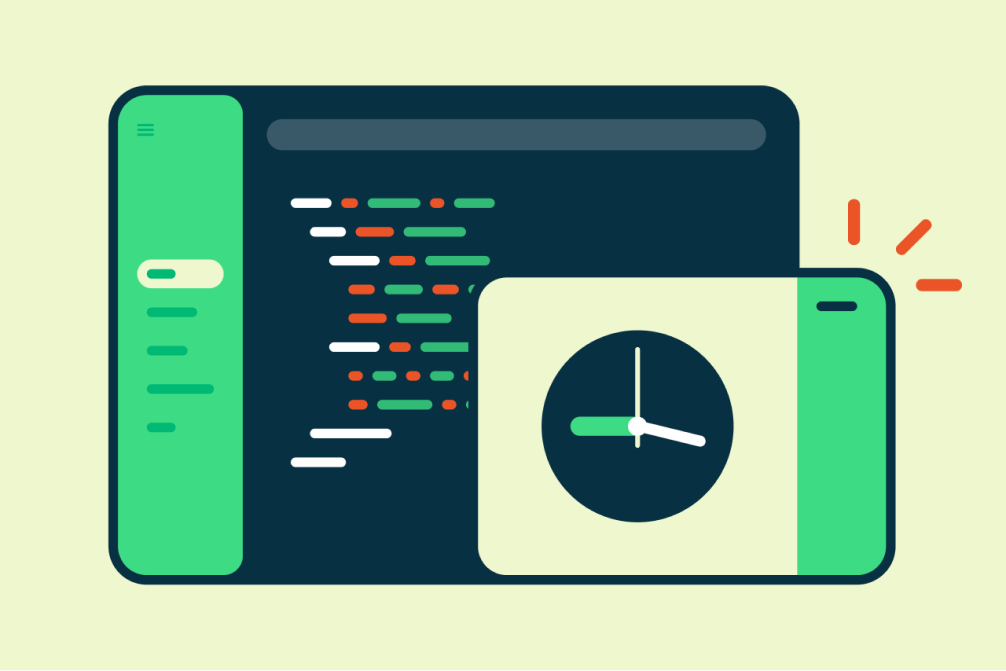注: Wear OS 5 以降がプリインストールされたデバイスにウォッチフェイスをインストールする場合、および Google Play で公開されるすべての新しいウォッチフェイスには、Watch Face Format が必要です。
2026 年 1 月より、すべての Wear OS デバイスにウォッチフェイスをインストールするには、Watch Face Format が必要になります。
ユーザー向けの変更について詳しくは、ヘルプセンターの記事「アプリの変更が審査、公開されるタイミングを管理する」をご参照ください。

ユーザーがスマートウォッチをチェックする際に最初に見るのがウォッチフェイスで、Wear OS で最も使用されるサーフェスになっています。ユーザーはウォッチフェイスを使用して、スタイルに合わせてスマートウォッチをカスタマイズし、情報を一目で確認できるようにします。
ウォッチフェイスの作成オプション
Watch Face Format(WFF)により、ウォッチフェイスの作成がこれまで以上に簡単になりました。Samsung とのパートナーシップにより作成された Watch Face Format は、ウォッチフェイスの外観と動作を構成する宣言型 XML 形式です。他のウォッチフェイス API では、ウォッチフェイスをレンダリングするコードを APK に含める必要がありますが、Watch Face Format ではリソースと宣言型命令のみが必要です。Wear OS プラットフォームはウォッチフェイスのレンダリングに必要なロジックを処理するので、コードの最適化やバッテリーのパフォーマンスではなく、クリエイティブな発想に集中できます。
この形式でビルドされたウォッチフェイスは、以前の Jetpack ウォッチフェイス ライブラリを使用して作成されたものよりも、メンテナンスの手間が減り、更新が少なくて済みます。たとえば、パフォーマンスやバッテリー消費の改善、最新のバグの修正などを行うために、ウォッチフェイスを更新する必要はありません。
ウォッチフェイスを作成する方法はいくつかあります。
- ウォッチフェイスを直接デザインできる WYSIWYG スタイルのツールをご希望の場合は、Samsung とのパートナーシップでサポートしているウォッチフェイス スタジオをご利用ください。
- デザイナーとして Figma を使い慣れている場合や、デベロッパーとしてウォッチフェイスの作成の最初の数ステップを加速させたい場合は、Figma 内のプラグインを使用してアクセスする Watch Face Designer を使用します。
スマートウォッチの設定を手動で管理し、独自のアプリストアに公開する場合は、XML を使用してウォッチフェイスを定義できます。Android Studio には、Watch Face Format を使用するウォッチフェイスのビルドのサポートが含まれています。これらのウォッチフェイスは、デバイスで実行することで可視化できます。
作成したウォッチフェイスは、Google Play や Watch Face Push など、さまざまな方法で公開できます。
フォーマットについて
Watch Face Format(WFF)のウォッチフェイスの中心となるのは、ウォッチフェイスのレイアウトと動作を定義するドキュメントです。このドキュメントは、WFF 仕様に準拠した XML で記述されています。
Wear OS システムには、ウォッチフェイス レンダラ コンポーネントが含まれています。このコンポーネントは、WFF XML ドキュメントを解析し、そこからウォッチフェイスをレンダリングします。画像やフォントなどの他のリソースは、必要に応じて取得されます。
このアプローチでは、ウォッチフェイスの見た目を説明するだけで、ウォッチフェイスを描画するコードはすべて Wear OS が処理します。
Watch Face Format のウォッチフェイスをデバイスにデプロイするには、XML ドキュメントを標準の AAB または APK パッケージにパッケージ化します。
次の図は、このアプローチの概要を示しています。

WFF のバージョニング
WFF の進化に伴い、追加機能が追加され、より多くの要素、属性、データソースで表されるようになります。これらはすべてウォッチフェイス フォーマットを使用します。
たとえば、WFF バージョン 2 では、WFF バージョン 1 では利用できないデータソースとして天気予報のサポートが導入されました。
ウォッチフェイスをデザインする際は、使用したい機能とそのバージョンが利用可能かどうかを把握しておいてください。リファレンス ガイドには、すべての機能とその利用可能性が記載されています。
WFF の各バージョンは Wear OS のリリースに対応しています。
| WFF バージョン | Wear OS の最小バージョン | 最小 API レベル |
|---|---|---|
| 1 | 4 | 33 |
| 2 | 5 | 34 |
| 3 | 5.1 | 35 |
| 4 | 6 | 36 |
AndroidManifest.xml と Gradle ビルドファイルを適切に構成するには、こちらのガイダンスをご覧ください。
詳細
Watch Face Format について詳しくは、以下のガイドをご覧ください。
- 利用可能な機能: Watch Face Format の各バージョンでサポートされているウォッチフェイスの機能を確認します。
- 設計ガイドライン: ウォッチフェイスのレイアウトとユーザー エクスペリエンスのベスト プラクティスをご覧ください。
- Watch Face Designer: Figma プラグインを使用してウォッチフェイスを作成する方法について説明します。
- セットアップ: Watch Face Format をサポートする Android App Bundle を構成します。
- GitHub サンプル: ウォッチフェイスのサンプルを作成して、Wear OS エミュレータまたは実機にデプロイする方法を紹介します。
- メモリ使用量を最適化する: ウォッチフェイスのレンダリング時にシステムによって消費されるメモリ量ができる限り少なくなるように、ウォッチフェイスを構成する方法について説明します。
- XML リファレンス: Watch Face Format のファイルに含まれる個々の要素を探します。ルート要素は常に
WatchFaceです。注: XML リファレンスで特定の Watch Face Format バージョンの機能を表示するには、ドキュメント ページの上部で適切なバージョン ボタンが選択されていることを確認してください。 - 公開ガイド: Google Play ストアやその他の方法でウォッチフェイスを公開して収益化する方法を紹介します。
- WFF とメモリ検証ツール: これらのオープンソース ツールを使用して、Google Play に送信する前に、ウォッチフェイス フォーマット ファイルのエラーをチェックし、許容可能なメモリ使用量を確認します。

